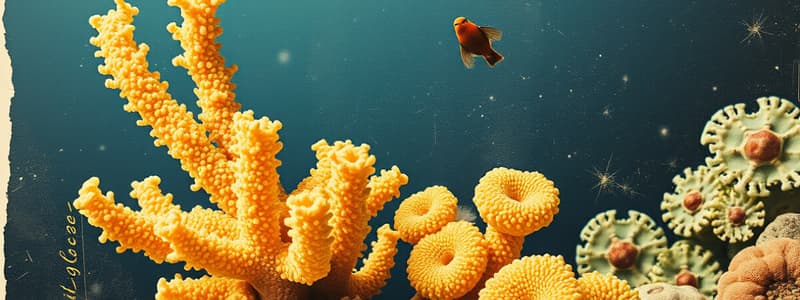Podcast
Questions and Answers
Which of the following are characteristics of Grantia? (Select all that apply)
Which of the following are characteristics of Grantia? (Select all that apply)
- Eukaryotic (correct)
- Heterotrophic (correct)
- Multicellular (correct)
- Photosynthetic
What is the classification of Grantia?
What is the classification of Grantia?
Domain: Eukarya, Kingdom: Animalia, Subkingdom: Parazoa, Phylum Porifera, Common Name: Sponge
Where is the habitat of Grantia?
Where is the habitat of Grantia?
Coastline of the North Atlantic, Intertidal regions
How does Grantia obtain food?
How does Grantia obtain food?
What type of skeleton does Grantia have?
What type of skeleton does Grantia have?
Grantia is a motile organism.
Grantia is a motile organism.
What are the adaptations of Grantia?
What are the adaptations of Grantia?
Describe the reproduction process of Grantia.
Describe the reproduction process of Grantia.
Name two friends of sponge.
Name two friends of sponge.
What is the purpose of the osculum in Grantia?
What is the purpose of the osculum in Grantia?
What is a spongocoel?
What is a spongocoel?
What is the function of choanocytes in Grantia?
What is the function of choanocytes in Grantia?
The filter feeding process in Grantia flows as follows: Water --> outside --> ______ --> spongocoel --> osculum --> out of body.
The filter feeding process in Grantia flows as follows: Water --> outside --> ______ --> spongocoel --> osculum --> out of body.
Flashcards
What is a Grantia?
What is a Grantia?
A multicellular, eukaryotic organism that obtains nutrients from organic matter.
What is the spongocoel?
What is the spongocoel?
A specialized cavity within the Grantia that is lined with flagellated cells. It facilitates water flow and food capture.
What is the osculum?
What is the osculum?
A large opening at the top of the Grantia through which water and waste products are expelled from the spongocoel.
What are ostia?
What are ostia?
Signup and view all the flashcards
What are Choanocytes?
What are Choanocytes?
Signup and view all the flashcards
What is filter feeding?
What is filter feeding?
Signup and view all the flashcards
What is the skeletal structure of Grantia?
What is the skeletal structure of Grantia?
Signup and view all the flashcards
What is spongin in the context of a Grantia?
What is spongin in the context of a Grantia?
Signup and view all the flashcards
What are spicules?
What are spicules?
Signup and view all the flashcards
How does Grantia reproduce?
How does Grantia reproduce?
Signup and view all the flashcards
Explain sexual reproduction in Grantia.
Explain sexual reproduction in Grantia.
Signup and view all the flashcards
Explain asexual reproduction in Grantia.
Explain asexual reproduction in Grantia.
Signup and view all the flashcards
What is the motility of Grantia?
What is the motility of Grantia?
Signup and view all the flashcards
Study Notes
Grantia Characteristics
- Eukaryotic organism with a multicellular structure.
- Heterotrophic, obtaining nutrients from organic matter.
Grantia Classification
- Classified under Domain: Eukarya and Kingdom: Animalia.
- Subkingdom: Parazoa, indicating a lack of true tissues and organs.
- Phylum: Porifera; commonly known as sponges.
Grantia Habitat
- Found along the coastline of the North Atlantic.
- Commonly inhabits intertidal regions.
Grantia Energy/Food Source
- Features a spongocoel, an internal cavity lined with flagellated cells.
- Flagella beat to draw in water, fine organic particles, and microorganisms through the body wall's tiny pores.
- Food particles are captured in mucilaginous material and absorbed by cells for digestion.
- Waste and excess water exit the spongocoel through the osculum at the sponge's top, a process known as filter feeding.
Grantia Type of Skeleton
- Comprised of loose aggregations of various cell types and fibrous proteins, notably spongin.
- Contains hard spicules made of calcium carbonate or silica for structural support.
Grantia Motility
- Primarily sessile, with limited movement in larvae and sperm.
Grantia Adaptations
- Flagellated cells enhance water flow into the spongocoel, facilitating nutrient acquisition.
- Stalk structure anchors the sponge to prevent drifting.
- Presence of spicules serves as a physical deterrent against predators.
Grantia Reproduction
- Hermaphroditic, possessing both male and female reproductive structures.
- Sexual reproduction involves releasing sperm into seawater, fertilizing eggs within other sponges.
- Zygote develops into an embryo that transforms into a flagellated larva, which exits through the osculum and eventually settles to form a new colony.
- Asexual reproduction occurs via fragmentation; broken pieces can regenerate into new sponges.
Sponge Friends
- Associated sponge species include Alpysina and Spongilla.
Osculum
- Large opening through which water and waste products are expelled from the spongocoel.
Spongocoel
- The internal cavity characterized by flagellated cells.
- Functions in drawing water and organic particles into the sponge through ostia (small pores).
Ostium
- Small openings in the body wall that facilitate water entry into the spongocoel.
Choanocytes
- Specialized flagellated cells crucial for water circulation and feeding.
Filter Feeding Process
- Sequence: Water enters through ostium, flows into spongocoel, exits through osculum.
Studying That Suits You
Use AI to generate personalized quizzes and flashcards to suit your learning preferences.



